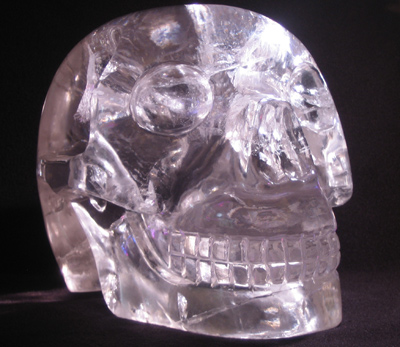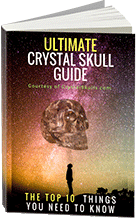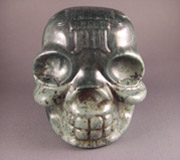Mitchell Hedges Skull controversy
-Rebuttal-
Courtesy of The Mitchell-Hedges Official Website
Perhaps because of its popularity, the authenticity of Mitchell-Hedges Crystal Skull is often challenged.
The German origin of the skulls
Claims exist that there is “near proof” about how the skulls have been traced to a German village that specialized in crystal. Though it is indeed true that this village had many experts in working with crystals, there is no evidence that they made any or several crystal skulls. Worse, there is not a single piece of evidence which connects the French antiquities dealer Boban (or any other Mexican antiques dealer) with the crystal manufacturers of this village. The claim made by some that it is likely or almost proven that several skulls were fabricated in this village, is unsupported by evidence. It is an unsubstantiated theory, and is hence without scientific validity.
The 1943 auction of the “Skull of Doom”
Certain people have made a lot about how Mitchell-Hedges bought the skull at auction in 1943. This is an undisputed fact. But this “revelation” takes the focus away from the fact that the skull is known to have existed in 1936, when it was studied by the British Museum. The report stated that it could not trace the skull’s existence beyond 1934.
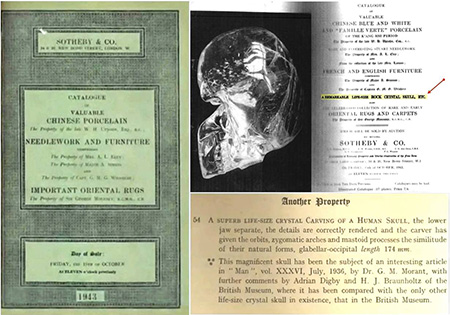
No evidence has been uncovered how Burney acquired it, or that he felt it was of recent origin. If he did acquire it as a “modern fake”, he would surely not have taken the risk and submitted it for testing by the British Museum in 1936? Furthermore, noting that Burney and Mitchell-Hedges were friends, all the available evidence is definitely in favor of Mitchell-Hedges possessing the skull in the early 1930s – which in itself does nothing for or against the age or origin of the skull.
The “controversial” Boban
Jane Walsh should be commended for tracing the Paris and British Museum skull back to Eugène Boban. However, no-one has uncovered any evidence that the Mitchell-Hedges skull has any connection with Boban.
Furthermore, there is no evidence whatsoever that Boban ordered these skulls in Germany, or knew they were fake. As all art dealers, some fake artifacts did pass through his hands, but he is known to have been a man who spoke out against fakes, and felt the sale of fake artifacts was counter-productive for the market in which he was operating. He personally crusaded against frauds and fakes, such as in 1881, when he spoke out against forgeries that were being made in the suburbs of Mexico City.
A contemporary art dealer, Wilson Wilberforce Blake, at a time when he was openly claiming that everyone should buy from him, not Boban, did claim the skull was fake. No shred of evidence exists to substantiate this allegation – which had clear economical motives.
“A third generation skull”
Walsh has labeled the Mitchell-Hedges skull as a third generation skull, seeing it is the most detailed and best of the crystal skulls known to exist. She therefore considers it more modern than the Paris and British Museum skulls. It is implied therefore to be post-Boban. However, no evidence has been produced for her claim, and as the skull is allegedly even more recent than Boban’s, one would expect there to be evidence that is easily obtainable. However, none is produced.
Furthermore, as enticing as her generational approach to cataloguing the skulls is, it suggests a group of people perfecting their techniques over time and thus their end product becoming ever more refined. However, in the case of the crystal skulls, we are talking about 5 to 6 artifacts, which, if indeed of recent origins, were still apparently produced over a period of 40 to 60 years (ca. 1860-1900-1920 AD), which has innate problems:
a. one person would likely only do one skull in his lifetime;
b. there is no evidence at all to argue that the more basic skulls are older than e.g. the Mitchell-Hedges one;
c. there is no evidence that all skulls come from the same location, let alone the same “crystal factory”;
d. why would this German town only have sold to or via Boban, and not put such crystal skulls in their “general catalogue” and on sale elsewhere and locally?
Hence, this generational cataloguing is without any foundation in fact and at present pure speculation.
Evidence of wheels in production as proof of post-Columbian/modern origin
Walsh et al. claim that the presence of evidence on the skulls that wheels were used, is evidence of not only post-Columbian, but specifically modern origins.
However, this conclusion is at odds with the evidence. The crystal skull owned by Mexican Norma Redo supports a large crucifix on its top. This skull shows evidence of wheelwork. But from his analysis, archaeologist Dr Andrew Rankin has argued that the skull was sculpted from the same crystal as that of the crystal goblet from tomb no. 7 at Monte Albán, which is an uncontested archaeological find.
Furthermore, the 1571 hallmark on the crucifix is also deemed to be genuine, thus in general excluding the likelihood that this skull is of 19th century European fabrication. This suggests the skull dates from 1571 or earlier. Though it does not prove the skull is pre-Columbian, it does indicate that crystal skulls were made in Mexico before 1600.
Finally, Professor Michael D. Coe of Yale University stated that evidence of wheel markings in no way proves that the skulls are modern. He stated that although it has long been accepted that no pre-Columbian civilization used the rotary wheel, new evidence contradicts this scientific dogma. Wafer-thin obsidian ear-spools are now known to have been made using some rotary carving equipment and to be dated to the Aztec/Mixtec period. According to Chris Morton and Ceri Louise Thomas in The Mystery of the Crystal Skulls, Coe concluded (p. 226): “People who sit in scientific laboratories don’t know the full range of the culture they’re dealing with. We really don’t know half as much about these early cultures as we think we do. People need to re-examine their beliefs.”
Psychic powers, Atlantis, and alien origins
We cannot be held responsible for other people’s opinions or theories about the origins of the crystal skull. Throughout her lifetime, Anna Mitchell-Hedges was accommodating to psychics, artists and scientists who wanted to work or study the artifact. Claims that she never allowed the skull to be scientifically tested, are erroneous.
Equally, F.A. Mitchell-Hedges never stated the skull was from Atlantis, or an extra-terrestrial civilization, or like. In fact, he is on the record, in his autobiography “Danger My Ally”, as stating his conviction that the skull was a Native American artifact, used by local shamans in their “esoteric rites”.
Courtesy of the original Mitchell-Hedges Official Website
Read this fascinating article on the origins of the Mitchell-Hedges Crystal Skull (now called The Skull of Love) and listen to this Audio Interview and see this Crystal Skull Video Presentation that further explores the mystery of the MH Crystal Skull
Mitchell-Hedges |
Size: 11.91 lbs / 5.4 kgs |
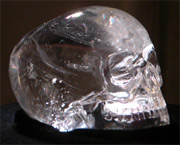 |
Stone: Clear Quartz |
Origin: Belize |
"Skull of Love"
Discovered in 1923 - Most famous for its detachable jawbone. |
More info on the Skull of Love |
Photo Credit |
|
Anna Mitchell-Hedges (affectionately known as "Sammy" to her friends ) passed away in 2007 at the age of 100. Find out the real story behind the Mitchell-Hedges Crystal Skull from a close friend of
Anna Mitchell-Hedges.
This free report will give you
insights you will not find anywhere else.
Fill out this form so we can email you this exclusive information right away. |

|



